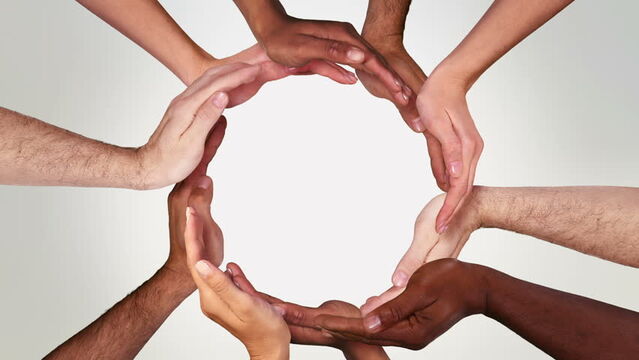Attention
Circling: A Personal Perspective on Finding Genuine Connection
A powerful tool for creating deep person-to-person contact.
Posted December 6, 2021 Reviewed by Kaja Perina
Key points
- The goal of Circling is for a group to see the world through your eyes.
- People flourish under the influence of caring, curious, and non-judgmental attention. So does the connection between them.
- Circling involves as much unlearning of communication skills as learning them.

“The tools we use to heal the wounded human heart are the most important technology of the 21st century.” — UC Santa Cruz scientist Bruce Damer
The classic sci-fi novel Stranger in a Strange Land introduced into our language the word “grok,” to understand someone or something so thoroughly you nearly merge with it, and it with you. As author Robert Heinlein put it, “The observer becomes part of the observed.”
Anyone who's ever had the experience of feeling “grokked”—truly seen, known and understood by another—knows the experience at the heart of Circling, an open-source brand of communal conversation—some call it “relational yoga”—which is now practiced in over 60 communities in 45 states and 12 countries, and taught in roughly a dozen training schools.
Begun in the San Francisco Bay area in the mid 90's by Guy Sengstock, Circling's objective is to focus a group's compassionate and undivided attention on an individual, to double-click on their life and “get their world,” coming to know what it feels like to be them, to see the world through their eyes. Or as one Circler put it, “It's a structured way to love the crap out of someone.”
A community's well-being is a function of the quality of its relationships, the sense of connection and relatedness among its citizens—sometimes called “social capital”—and creating that capital comes down to the small acts of being together, to the question, “How are we going to be when we gather together?” And in a world crying out for across-the-aisle conversation, for connection rather than divisiveness, a world in which we can have 5000 Facebook friends and no-one to call in a crisis, techniques likes Circling offer something that's in increasingly short supply in our social-mediated world—genuine human-to-human contact and the visceral experience of feeling understood.
Circling is designed to cut through the crust of superficiality and alienation that attend so many interpersonal encounters, and drop people into the deeper waters of connection, into what Circlers call “we space”—the relational field that exists between people.
It's also designed to help participants examine the thoughts behind their thoughts, the assumptions behind their opinions, the active ingredients in intimacy and alienation, and the peculiar alchemy that turns stranger into friend.
I've attended Circling groups in three of those 45 states, and I'm routinely struck by what happens to people under the influence of caring, curious, attentive, non-judgmental attention—how they blossom right on the spot and begin to let down their drawbridges. How tender and lovable they become. And it touches deeply on our collective need for not just relationship-building, but community-building and cultural exchange.
Unlike therapy, circling is not about heading off destructive patterns, hunting for mental health, or focusing on the past, and unlike coaching it's not about enhancing performance or focusing on the future. Circling is squarely focused on the present moment, the one-and-only Now, and on staying in the room. That is, no fast-forwarding with questions like “If you stopped doing X, what do you think would happen?”
The point is to focus on what's happening with and within the Circlee in present-tense, amplifying practices that are known to create connection (curiosity, empathy, vulnerability, appreciation, undivided attention), while minimizing practices known to create disconnection (judgment, agenda, opinion, psychoanalyzing, and questions that are more interrogative than inquisitive). There's no attempt to heal, empower, advise, coach, or go for the “pop”—the aha, the emotional release. And Circling facilitators are vigorously trained to mine-sweep for these tactics.
How It Works
The process begins by sitting in a circle with typically 4-10 people, and if you volunteer to be the Circlee, you might share a situation you're grappling with or an emotion that's dominating your attention—and all the focus is on you. The Circlers attempt to step into your world, not pull you into theirs, so there's no fixing, problem-solving, advice-giving, storytelling, or devil's-advocate questions that tend to be a little heavy on the devil and a little light on the advocate.
The Circlers just ask questions, share reflections and impacts, and report on their own moment-by-moment experience of being in your world. What they're after is what NPR commentator Krista Tippett, in her book Becoming Wise, calls “generous listening,” which is powered by curiosity, the desire to understand the humanity behind your words:
* “You seem frustrated. Does that fit for you?”
* “I feel restless when you talk about your work, but engaged when you talk about your family. How does it feel to hear that?”
* “I notice your eyes dart around a lot when you talk about your father. What's going on for you in those moments?”
* “Let me pause you there for a moment, so I understand what you're saying.”
* “You spoke about jealousy. What's jealousy like for you?”
* “I imagine this situation makes you feel angry. Is that accurate?”
* “As I listen to you, something I wonder about you is…..”
Clearly, this is not the way most of us learned to communicate, and Circling can be hard to grasp at first. The language is unnatural, the rules unfamiliar, the sound of it awkward—and the willingness to make mistakes essential.
During one of the Circles I was in recently, I twice asked the Circlee what might change in her situation if she did thus-and-such differently, and the first time the facilitator gently redirected my inquiry back to the present, and the second time I caught it.
To be sure, Circling involves not just learning but unlearning communication skills, including the tactics we've developed over a lifetime to keep conversational attention focused on us, looking to assert our opinions, agendas, assumptions, and judgments, and if we apply curiosity at all, it's often merely a form of in-air refueling before turning the conversation back to ourselves.
But with Circling, we're having to cultivate actual curiosity about others instead of just waiting for our turn to talk, or simply cutting in line. We're having to practice an attention-giving tactic called support-response (encouraging the other guy to talk), rather than the attention-getting tactic called shift-response (constantly shifting the focus back to yourself). If a Circlee tells you she's having a hard day and you say, “Me too,” that’s shift. If you say, “How come?” that’s support. And we're having to prioritize connection over competition, which might be especially hard for anyone who equates circling behavior with sharks and vultures.
But like so much of communal life, Circling—and connecting with others—requires a decentralizing of self, an extending of awareness beyond our own borders, into the spaces we share with others, into others themselves.
When people are enveloped in caring, curious, non-judgmental attention—truly heard, felt, and seen—they unburden themselves. They see themselves more clearly in the light of other people's loving attention. They smile and shine, let down their guards, offer up their confusion and distress to the compassionate care of others. They fill with gratitude. They also find themselves disinclined to settle for less in their other relationships.
In another recent Circle, I asked a woman who was being Circled about the gesture of holding her hands up against her chest while she was talking—one hand in a fist against her sternum, the other cupped over it. I told her it looked self-protective, and asked if it felt that way. Yes, she said, given the vulnerability she was sharing, though over the next few minutes she relaxed, and her hands fell gently into her lap, which she spoke of noticing.
It seemed to me a small gesture—the shift from holding her hands protectively over her heart to letting them relax into her lap—but it's also a big gesture. And in it, I think, is the whole history of our sundered sense of connection to one another, all that's ever kept us apart and to ourselves: fear, competition, ignorance, autonomy, self-preservation.
But in a single moment of paying genuine and compassionate attention to one another, a split second of being self-forgetful like the swamis, that space between us can be straddled, and we're no longer strangers in a strange land.
For more about Passion! visit www.gregglevoy.com




